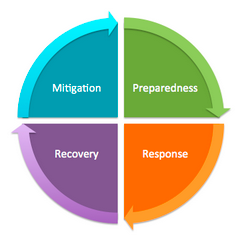Enterprises have long been embracing the concept of Web 2.0 by making their legacy systems more collaborative, encouraging information sharing, and focusing on a user centered design.
How about using Web 2.0 capabilities in systems for managing incidents and emergencies?
There are four major stages of emergency management: preparedness, response, recovery, and mitigation.
Preparedness
This is a stage where emergency managers develop plans of action to execute when disaster strikes. Emergency contingency plans, communication plans, evacuation plans, and multiagency coordination plans are some of the key plans designed at this stage. Using these plans effectively in the event of an actual emergency is a key challenge in emergency preperation.
Using web based emergency management platforms, one can translate these plans into actionable tasks in the event of an emergency and monitor the progress easily. Using GIS technology, these plans can be mapped on a geographical map for modeling evacuation routes and identifying strategic facilities.
Response
This is a stage where one responds to an emergency situation by mobilizing key resources, emergency services, and first responders. This is an area where emergency managers have always faced problems in collaborating between the various response teams.
Web 2.0 and social media powered emergency management platforms can solve these problems because they are built from the beginning to facilitate information sharing and collaboration. Response to incidents and emergencies is now not only instant but also well integrated and coordinated between the various emergency teams.
Recovery
This is a stage where one needs to restore the situation to its original state. Again, Web 2.0 powered systems empower emergency operation command centers with factual data to better assess the damage and come up with actionable recovery plans.
Mitigation
This is a stage where efforts are made to prevent the incidents from happening again or to reduce the effects of these incidents. Transcripts from the communication that has taken place during the course of the emergency response is a great place to start looking for mitigation opportunities.
Using Web 2.0 features in emergency management platforms will foster collaboration, provide instant access to information, and enhance communication between multiple teams that will ultimately help make better decisions in crisis situations.
What emergency management platforms are you using and what are your key challenges?








